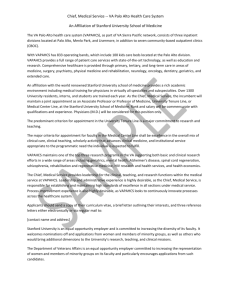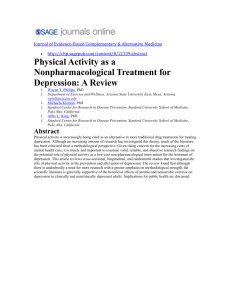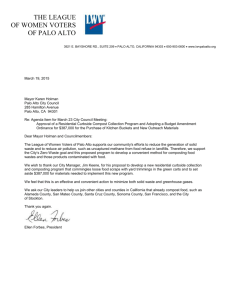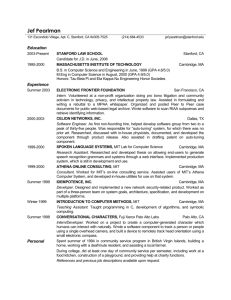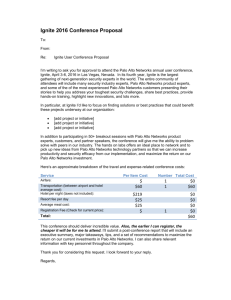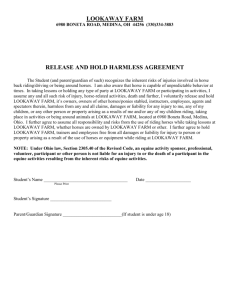Horsing around at the Palo Alto Stock Farm
advertisement
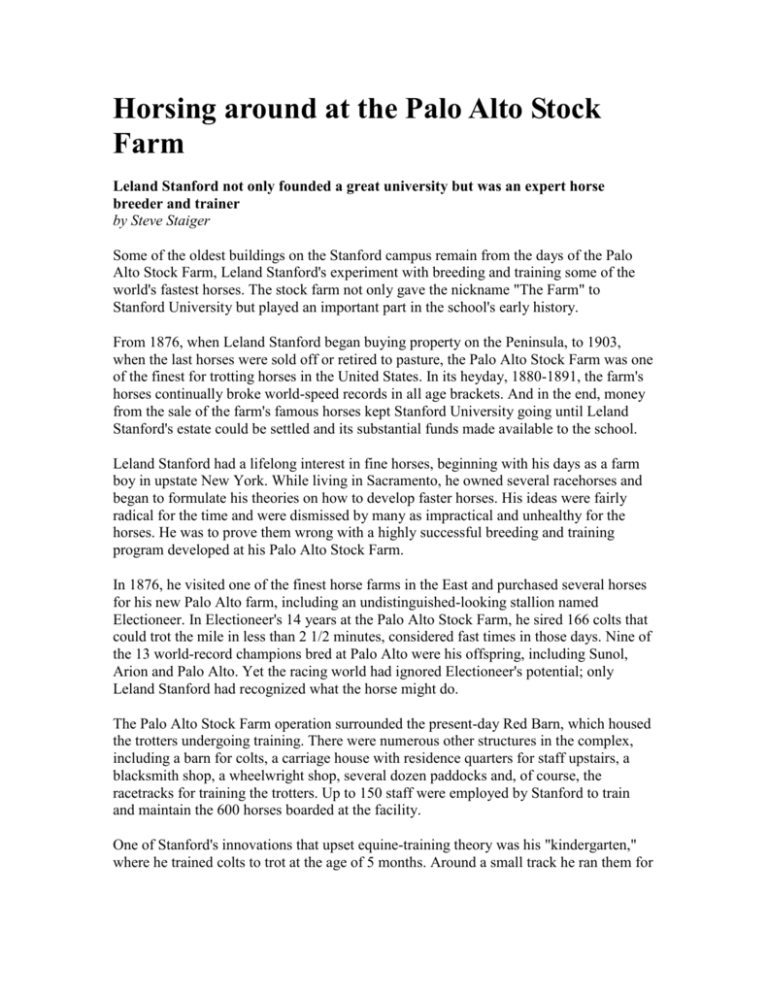
Horsing around at the Palo Alto Stock Farm Leland Stanford not only founded a great university but was an expert horse breeder and trainer by Steve Staiger Some of the oldest buildings on the Stanford campus remain from the days of the Palo Alto Stock Farm, Leland Stanford's experiment with breeding and training some of the world's fastest horses. The stock farm not only gave the nickname "The Farm" to Stanford University but played an important part in the school's early history. From 1876, when Leland Stanford began buying property on the Peninsula, to 1903, when the last horses were sold off or retired to pasture, the Palo Alto Stock Farm was one of the finest for trotting horses in the United States. In its heyday, 1880-1891, the farm's horses continually broke world-speed records in all age brackets. And in the end, money from the sale of the farm's famous horses kept Stanford University going until Leland Stanford's estate could be settled and its substantial funds made available to the school. Leland Stanford had a lifelong interest in fine horses, beginning with his days as a farm boy in upstate New York. While living in Sacramento, he owned several racehorses and began to formulate his theories on how to develop faster horses. His ideas were fairly radical for the time and were dismissed by many as impractical and unhealthy for the horses. He was to prove them wrong with a highly successful breeding and training program developed at his Palo Alto Stock Farm. In 1876, he visited one of the finest horse farms in the East and purchased several horses for his new Palo Alto farm, including an undistinguished-looking stallion named Electioneer. In Electioneer's 14 years at the Palo Alto Stock Farm, he sired 166 colts that could trot the mile in less than 2 1/2 minutes, considered fast times in those days. Nine of the 13 world-record champions bred at Palo Alto were his offspring, including Sunol, Arion and Palo Alto. Yet the racing world had ignored Electioneer's potential; only Leland Stanford had recognized what the horse might do. The Palo Alto Stock Farm operation surrounded the present-day Red Barn, which housed the trotters undergoing training. There were numerous other structures in the complex, including a barn for colts, a carriage house with residence quarters for staff upstairs, a blacksmith shop, a wheelwright shop, several dozen paddocks and, of course, the racetracks for training the trotters. Up to 150 staff were employed by Stanford to train and maintain the 600 horses boarded at the facility. One of Stanford's innovations that upset equine-training theory was his "kindergarten," where he trained colts to trot at the age of 5 months. Around a small track he ran them for 20 minutes each day, gradually increasing the speed at which they were run. Normal training practices held colts out of a training schedule until they were much older. The validity of Stanford's theory and practice became apparent as his trotters made their debuts and won numerous ribbons and trophies. In 1888, Sunol was the fastest 2-year-old in the world, and in succeeding years she held the record for 3-, 4- and 5-year-olds, making her the first trotting horse to hold all age records. Arion broke Sunol's record for 2-year-olds in 1891 with a record time that stood for 18 years. Another of Electioneer's offspring, Palo Alto, was thought to be the finest horse ever bred at the farm. Because of a fire that destroyed a barn and several horses as well as injuring Palo Alto, Stanford had a fireproof brick stable built for his finest horses. Unfortunately, the damp conditions in the brick stable weakened several horses, including Palo Alto, who died from pneumonia in 1892. The brick stable remains today, used by the golf course to store equipment and supplies. It can be seen just southwest of the Red Barn. Aside from the Red Barn and the brick stable, there is little physical evidence of the Palo Alto Stock Farm today. The open fields north of the Red Barn, where the training tracks once stood, are used by the Stanford equestrian team to practice and train for intercollegiate competitions. But this may end soon, as Stanford officials have designated this area for future housing. Incidentally, the Stanford Barn located adjacent to the Stanford Shopping Center was never part of the Palo Alto Stock Farm. It was built as a winery to process grapes from the vineyard planted on the site of the present-day shopping center. The stock farm was never a profitable business venture, but Leland Stanford didn't plan it as such. It was a hobby, a way to relax and enjoy time away from his business ventures, much as a wealthy individual today might finance a stable of race cars or a racing yacht. Although not a business, the operation did generate revenue through the sale of numerous horses, including offspring of Electioneer. Sunol sold for $41,000, Bell Boy brought $51,000, and Arion was sold for $125,000. The stock farm and its training methods have been credited by some for the Stanfords' advocating a co-educational university in memory of their son, when most educators preferred single-sex institutions. It was Leland's argument that just as the mother of a colt should be trained in order to teach her offspring properly, the mothers of future generations should be trained to teach their children during the child's first five years. Leland Stanford thought he would be remembered as the builder of the transcontinental railroad, the governor of California in the early days of the Civil War and the breeder of the world's finest trotting horses. But at the time of his death in 1893, he could not foresee the change in America coming with the newly developed automobile. For most people, trotting horses were to become a thing of the past. When Leland Stanford died, the federal government and others fought the wishes of his will, and it would be several years before his vast fortune was released for the benefit of the young university. Jane Stanford was able to finance a portion of the ongoing costs of running a college from her personal funds, but it was the breakup of the stock farm and the sale of its horses that helped Stanford University survive. In a Founders' Day ceremony many years later, university President David Starr Jordan reminded the crowd that it was "the horses that saved the university." A bronze sculpture of a horse stands near the Red Barn, marking the burial site of some of the famous horses that belonged to Leland Stanford and his Palo Alto Stock Farm.
